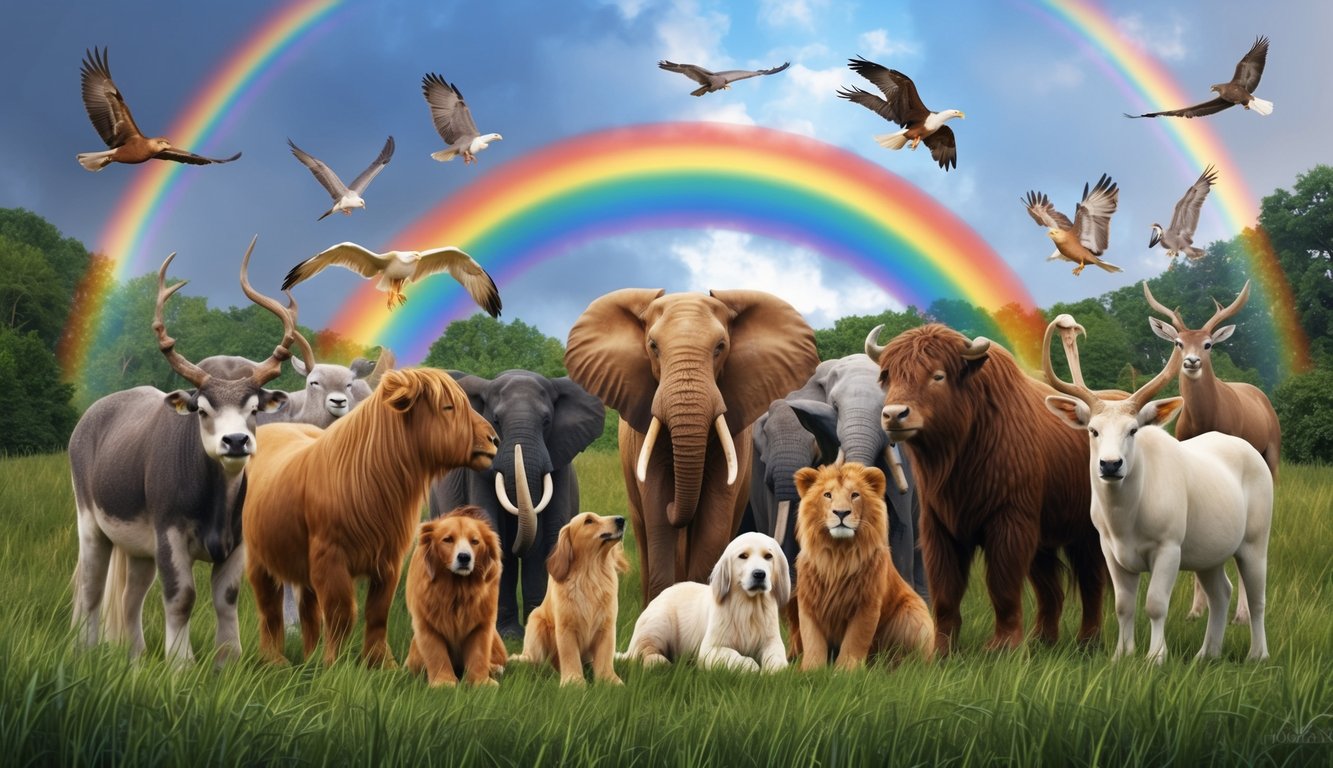Don’t Miss Out On This Unique Astrological Opportunity
Are you tired of spinning your wheels and getting nowhere? Simply put, you’re out of sync: you’re out of alignment with your astral configuration.
But: there’s a kind of map that can help you reclaim your alignment. Think of it as your own personal blueprint to success and happiness: a blueprint that will help you live your most amazing life.
Get started here.
Genesis 9 is a pivotal chapter in the Bible.
It introduces the covenant between God and humanity after the flood.
This covenant establishes a set of promises and rules for Noah and his descendants to follow, signifying a new beginning for life on Earth. God’s promise is symbolized by the rainbow, marking His commitment to never destroy the Earth with a flood again.
In Genesis 9, God charges humanity with the responsibility of being fruitful and multiplying, ensuring the continuation of life.
The chapter also outlines the sanctity of life, highlighting the importance of respecting living beings.
This passage reflects on both human imperfection and divine grace, offering lessons that are still relevant today.
Genesis 9 doesn’t just recount ancient promises; it challenges readers to consider their role in the broader story.
As you explore the descendants of Noah and the implications of the covenant, you will gain a deeper understanding of themes of grace, responsibility, and restoration that resonate through human history.
Key Takeaways
- God’s covenant with humanity is symbolized by a rainbow.
- Humanity is charged with preserving and respecting life.
- Genesis 9 reflects themes of grace and responsibility.
The Noahic Covenant
The Noahic Covenant is a fundamental part of the biblical narrative found in Genesis 9.
It outlines the agreements made between God and Noah after the flood, emphasizing God’s promises, the symbol of the rainbow, and the enduring nature of this covenant.
The Promises of God
In Genesis 9, God makes significant promises to Noah and his descendants.
He pledges never to destroy all life with a flood again, setting a foundation of hope and assurance.
This covenant extends to all living creatures, maintaining the balance between humans and beasts.
God’s promises highlight the sacredness of life, introducing the concept of respecting lifeblood.
He ensures that any shedding of human blood by another human or beast will be held accountable, reinforcing harmony among God’s creation.
This divine commitment underscores a relationship of trust and responsibility between God and all living beings on Earth.
The Sign of the Rainbow
The rainbow serves as a visible sign of God’s covenant with Noah.
When you see a rainbow, it is meant to remind both God and humans of the divine promise.
This symbol is highlighted in the text as appearing in the clouds, illustrating the bridge between heavenly and earthly realms.
The rainbow’s appearance after rain signifies God’s mercy and the cessation of dread.
It is a marker of the renewal and peace after past destruction.
As a sign, it provides a visual assurance to Noah and his descendants that God remembers the covenant.
This continuous reminder symbolizes hope and harmony in God’s creation.
The Everlasting Nature of the Covenant
The Noahic Covenant is described as everlasting, meaning it endures through generations.
It binds God, Noah, and all flesh covering future descendants.
The enduring nature ensures that the promises made—such as never flooding the Earth again—are perpetual.
You can consider this covenant an unbroken circle, symbolized by the endlessness of the rainbow.
This eternal promise from God signifies a lasting peace and stability on Earth, offering a foundation of trust for humanity.
It underscores God’s unfailing commitment to maintaining life on Earth and the duty of stewardship entrusted to Noah and his lineage.
The Charges to Humanity
In Genesis 9, God gives Noah and his descendants specific instructions.
These orders emphasize the sanctity of life and establish a framework for human interaction with creation, including both spiritual responsibilities and physical necessities.
Prohibition of Blood Consumption
You’re told not to consume animal blood.
This directive is linked to the belief that blood represents life itself.
Under these instructions, while you may eat meat, you must avoid consuming the lifeblood.
This command highlights a respect for all living creatures and distinguishes how life is treated.
The emphasis on avoiding blood consumption reinforces the connection between life and its sacredness.
By following this rule, you acknowledge God’s control over life and recognize the spiritual significance of blood.
Such guidelines make a clear distinction between mere existence and a life lived with respect, a sentiment you are called upon to adopt openly in your actions.
The Sanctity of Life and Law of Retribution
The value of human life is paramount.
God instructs you that any shedding of human blood—murder—demands accountability.
This retribution law underscores human life as created in the image of God.
If someone commits murder, they face consequences reflecting life’s sacred nature.
As you live among fellow creatures, like fish and birds, the emphasis on life’s sanctity defines your responsibilities.
By respecting these laws, you honor the divine image inherent in humanity.
Recognizing life’s worth promotes peace and reflects faith in God’s order.
By understanding the significance of life and the expected reverence for it, you cultivate a relationship with God and his creation that’s rich in respect and understanding.
The Descendants of Noah

Noah’s descendants played significant roles in shaping the future of different nations.
His three sons, Shem, Ham, and Japheth, each fathered various peoples, leading to diverse cultures and territories.
Shem, Ham, and Japheth
Noah had three sons: Shem, Ham, and Japheth.
Each of them became the ancestor of various groups.
Shem’s descendants are often linked to the Semitic peoples, which include ancient people like the Hebrews.
Ham is associated with nations like the Egyptians and Canaanites.
Japheth’s lineage is believed to include groups that spread throughout Europe and parts of Asia.
These lineages shaped the world’s cultural and ethnic landscapes as they expanded and settled in different territories.
The Incident in Noah’s Vineyard
The Bible describes an incident where Noah drank wine from his vineyard and became drunk.
While he was naked in his tent, Ham saw him uncovered and told his brothers. Shem and Japheth took a garment, walked backward, and covered Noah without looking at him.
This story is significant because it demonstrates how Shem and Japheth respected their father, while Ham did not.
This marked an important moment that further influenced the relationships between their families.
The Curse of Canaan and Blessings for Shem and Japheth
When Noah awoke and learned what Ham had done, he cursed Ham’s son, Canaan, saying he would be a “servant of servants.” This prophecy influenced the fate of the Canaanites, who later faced subjugation.
In contrast, Noah blessed Shem and mentioned that the Lord, the God of Shem, would be praised.
Japheth was also blessed, and it was said he would expand and dwell in Shem’s tents.
These blessings and curses set the stage for future relationships and territories among their descendants.
Reflections on God’s Grace and Human Imperfection

In Genesis 9, you see key moments that illustrate the balance between divine grace and human flaws.
The stories explore themes of righteousness, sin, and the promise of redemption through a divine covenant.
This chapter highlights God’s mercy in establishing a covenant with Noah, ensuring that life would continue despite human shortcomings.
The contrast between divine faithfulness and human error mirrors themes found in Genesis 3 and the Fall, where disobedience led to broken communion with God.
Yet, both passages emphasize hope, as God’s plan for redemption remains steadfast despite humanity’s failings.
The Duality of Human Nature
Genesis 9 portrays the complexity of human nature.
Noah, chosen by God for his righteousness, demonstrates both virtue and imperfection.
After the flood, Noah plants a vineyard and becomes drunk, revealing human vulnerability and the tendency to fall into sin.
Despite this, God’s love and grace remain evident, offering hope and forgiveness through a divine covenant.
You can see that both weakness and the potential for redemption coexist within humanity.
Lessons on Righteousness and Sin
The chapter offers lessons about righteousness and sin through the actions of Noah and his family.
When Noah’s son Ham exposes his father’s shameful state, it leads to a curse on Ham’s descendants.
In contrast, God blesses Shem and Japheth for respecting their father’s dignity.
These events underline the importance of respecting moral boundaries and the consequences of sinful behavior.
God’s grace remains consistent, providing guidance and offering a path to righteousness through faith and covenant.
The Foreshadowing of Redemption
Genesis 9 hints at future redemption through the divine covenant with Noah.
This covenant, expressed as a promise by God not to destroy the earth with another flood, is a symbol of grace and hope.
It prefigures the eventual coming of Christ and the Gospel, offering a future promise of redemption for humanity.
Even in times of personal challenges and afflictions, you find reassurance in God’s promises.
These themes continue to resonate, emphasizing the lasting nature of divine love and forgiveness through faith.
Frequently Asked Questions

In Genesis chapter 9, significant themes include the covenant between Noah and God, the introduction of dietary laws, and the symbolism of the rainbow.
The chapter also redefines human-animal relationships and signifies divine promises and changes in the natural order.
What is the significance of Noah’s covenant with God as described in Genesis chapter 9?
The covenant with Noah marks God’s promise not to destroy the earth with a flood again.
It establishes God’s commitment to preserving human life despite human imperfections.
What does the symbolism of the rainbow represent in Genesis 9:13?
The rainbow serves as a sign of the covenant between God and all living creatures.
It symbolizes peace and the assurance that floods will never again destroy all life.
In what ways does Genesis chapter 9 outline the dietary laws for Noah and his descendants?
God grants permission to eat all living creatures, similar to how green plants were given before.
However, consuming blood, which represents life, is strictly forbidden.
How is the relationship between humans and animals defined in Genesis 9?
The chapter establishes human dominion over animals.
Fear of humans is instilled in animals, reflecting a new dynamic where human needs take precedence.
What are the divine promises made to Noah and his family in Genesis 9?
God promises to sustain life and not curse the ground because of humanity.
The promise includes continued seasons and a stable natural order.
Can you explain the changes to the natural order that are established in Genesis 9?
In Genesis 9, seasonal cycles and the constant presence of day and night are introduced as part of the world’s permanence.
This ensures reliability and stability in the environment for future generations.



